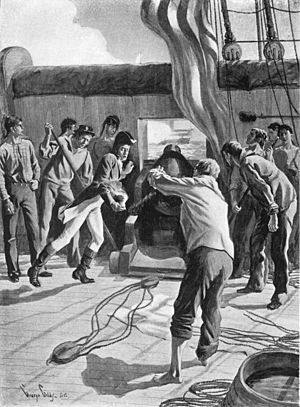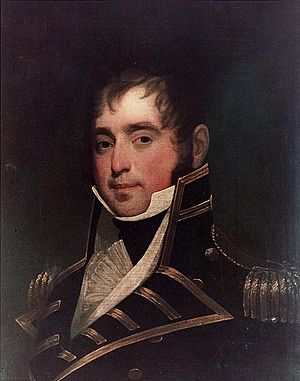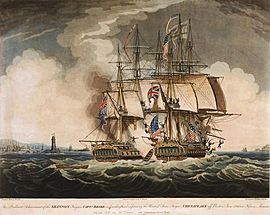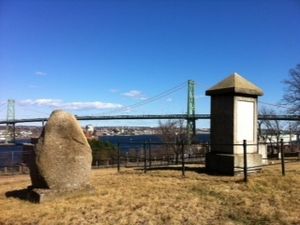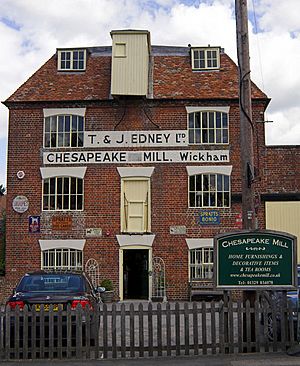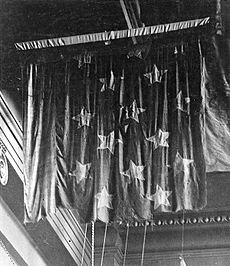USS Chesapeake (1799) facts for kids
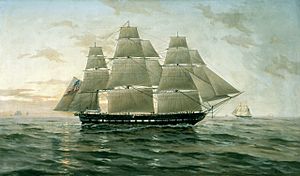
USS Chesapeake, painting by F. Muller (early 1900s)
|
|
Quick facts for kids History |
|
|---|---|
| Name | USS Chesapeake |
| Namesake | Chesapeake Bay |
| Ordered | 27 March 1794 |
| Builder | Josiah Fox |
| Cost | $220,677 |
| Laid down | December 1795 |
| Launched | 2 December 1799 |
| Commissioned | 22 May 1800 |
| Captured | 1 June 1813 |
| Name | HMS Chesapeake |
| Acquired | 1 June 1813 by capture |
| Decommissioned | 1819 |
| Fate | Sold for timber |
| General characteristics (1813) | |
| Class and type | 38-gun frigate |
| Tonnage | 1,244 |
| Length | 152.6 ft (46.5 m) lpp |
| Beam | 41.3 ft (12.6 m) |
| Draft | 20 ft (6.1 m) |
| Depth of hold | 13.9 ft (4.2 m) |
| Decks | Orlop, Berth, Gun, Spar |
| Propulsion | Sail |
| Complement | 340 officers and enlisted |
| Armament |
|
The Chesapeake was a powerful sailing ship of the United States Navy. It was a 38-gun frigate, which means it was a fast warship with many cannons. The Chesapeake was one of the first six frigates ever built for the U.S. Navy. These ships were designed to be strong enough to fight other frigates and fast enough to escape bigger warships.
The Chesapeake started its service during a conflict with France called the Quasi-War. Later, it fought in the First Barbary War in the Mediterranean Sea. A famous event involving the Chesapeake was the Chesapeake–Leopard affair in 1807. A British ship, HMS Leopard, fired on the Chesapeake because its captain refused a search for deserters. This event made many Americans angry and helped lead to the War of 1812.
During the War of 1812, the Chesapeake captured several British merchant ships. However, on June 1, 1813, it was captured by the British warship HMS Shannon. The British then used the Chesapeake in their own navy as HMS Chesapeake. In 1819, the ship was taken apart and its wood was sold. Much of its timber was used to build a mill in England called the Chesapeake Mill.
Contents
Building a Warship: The Chesapeake Story
Why Build the Chesapeake?
In the 1790s, American merchant ships faced attacks from pirates in the Mediterranean Sea. These pirates were from the Barbary States in North Africa. To protect American trade, Congress decided to build six new warships. This decision was part of the Naval Act of 1794. The law said that building these ships would continue unless the U.S. made peace with the pirates.
Designing a Powerful Frigate
Joshua Humphreys designed these new frigates. He made them long and narrow. This design allowed them to carry very heavy cannons. The ships also had strong wooden frames, making their hulls tougher than other frigates. Since the young United States couldn't build as many ships as European countries, Humphreys wanted his frigates to be able to beat other frigates in battle. They also needed to be fast enough to escape larger warships called "ships of the line."
Construction Challenges
The Chesapeake was first called "Frigate D." Its construction began in December 1795 in Virginia. Josiah Fox was in charge of building it. But in March 1796, the U.S. made a peace deal with the pirates. So, work on the ship stopped for two years.
In 1798, a new conflict started with France, known as the Quasi-War. Congress then decided to finish "Frigate D." When Josiah Fox returned to the shipyard, he found there wasn't enough wood. It had been sent to finish another ship. Fox then suggested a new plan to the Secretary of the Navy, Benjamin Stoddert. Fox wanted to make the ship smaller than Humphreys' original design. Secretary Stoddert agreed because he wanted to finish the ship faster and save money.
When it was finished, the Chesapeake was the smallest of the six frigates. It was about 152 feet long. The ship cost $220,677 to build. It was the second cheapest of the six frigates. The ship was officially named Chesapeake after Chesapeake Bay.
How Many Guns Did It Have?
The Chesapeake was officially rated as a 36-gun or 38-gun ship. But the number of guns a ship was rated for didn't always match the actual number of cannons it carried. For example, during its fight with HMS Leopard in 1807, the Chesapeake had 40 guns. In its battle with HMS Shannon in 1813, it had 50 guns.
These 50 guns included 28 large 18-pounder cannons on the main gun deck. It also had 18 smaller, powerful cannons called 32-pounder carronades on the upper deck. Ship captains could change their ship's cannons based on what they needed for a mission. So, the Chesapeake's weapons often changed throughout its time at sea.
Early Missions: Quasi-War and Barbary War
Fighting in the Quasi-War
The Chesapeake was launched on December 2, 1799. This was during the undeclared Quasi-War with France. The war started because the French navy was seizing American merchant ships. The Chesapeake was ready for sea in May 1800.
Its first job was to carry money from Charleston to Philadelphia. Then, it joined a group of ships patrolling the southern U.S. coast and the West Indies. They protected American merchant ships. On January 1, 1801, the Chesapeake captured a French privateer ship called La Jeune Creole. A privateer was a private ship allowed to attack enemy ships. After a peace treaty with France, the Chesapeake returned to Norfolk and was put into reserve in February 1801.
Patrolling in the First Barbary War
After the Quasi-War, the U.S. had been paying money to the Barbary States to protect its ships. But in 1801, the ruler of Tripoli, Yusuf Karamanli, demanded more money. President Thomas Jefferson sent warships to the Mediterranean to protect American ships and try to make peace. The Chesapeake was part of the second group of ships sent there, led by Richard Valentine Morris.
The Chesapeake left Virginia on April 27, 1802. It arrived in Gibraltar a month later. Its main mast had split during the trip, so it needed repairs. Morris stayed in Gibraltar for a while. He then sailed to Italy and Malta, protecting merchant ships along the way. The Chesapeake needed more repairs in Malta because its front mast (bowsprit) was rotting.
Morris was supposed to blockade Tripoli, but bad weather and low supplies made it difficult. He returned to Gibraltar. The Chesapeake then sailed back to the United States and was put into reserve in Washington D.C. in June 1803. Morris was later removed from the navy because he was seen as too slow and inactive during his command. People criticized him for spending too much time in port.
The Chesapeake–Leopard Affair
In 1807, the Chesapeake was being prepared for duty in the Mediterranean. James Barron was the overall commander. The ship needed many repairs and new crew members. Some of the new sailors had deserted from a British ship, HMS Melampus. The British ambassador asked for them back. Barron refused, saying they had been forced into British service.
On June 22, the Chesapeake left Norfolk, Virginia. A British squadron, including HMS Leopard, was blocking the port. As the Chesapeake sailed out, the Leopard followed it. The Leopard's captain, Salusbury Pryce Humphreys, asked to deliver messages. When a British officer came aboard, he gave Barron an order to search the Chesapeake for deserters. Barron refused.
As the British officer returned to his ship, Barron ordered his crew to get ready for battle. The Leopard then fired a warning shot, followed by a full broadside (all cannons firing at once). For 15 minutes, the Leopard kept firing. The Chesapeake was not ready to fight. Its cannons were not prepared, and the upper deck was messy. The Chesapeake only managed to fire one shot back before Barron surrendered.
The British boarded the Chesapeake and took four crewmen. Three American sailors were killed, and 18 were wounded, including Captain Barron. When the Chesapeake returned to port, people were furious. Mobs destroyed British water barrels and almost attacked a British officer. This event made Americans very angry and helped lead to the War of 1812.
An investigation found that Barron was guilty of not preparing his ship for battle. He was suspended from the navy for five years.
The War of 1812 and Final Battle
Early War Patrols
After the attack by Leopard, the Chesapeake was repaired. It then patrolled the New England coast. The Chesapeake–Leopard affair, along with other incidents, led the United States to declare war on Britain on June 18, 1812.
Under Captain Samuel Evans, the Chesapeake sailed into the Atlantic. It captured six British ships, including merchant vessels. One British warship chased the Chesapeake, but the American ship escaped during a storm. The Chesapeake's actions caused about $235,000 in damage to British shipping. It returned to Boston in April 1813 for more repairs.
Chesapeake vs. Shannon
Captain Evans was sick and left the Chesapeake. Captain James Lawrence, a hero from another naval victory, took command on May 20. But the ship was in a bad state. Many crew members' enlistments were ending, and they were leaving. Those who stayed were unhappy because they hadn't received their prize money from the last trip. Lawrence paid them from his own money to calm them down. The crew was a mix of new sailors and some from other ships.
Meanwhile, HMS Shannon, a 38-gun British frigate, was blocking Boston's port. Its captain, Philip Broke, was known for training his crew very well. They practiced gun drills for hours every day. This made Shannons crew very accurate with their cannons. The Chesapeakes crew, on the other hand, was new and hadn't had much practice together.
On June 1, 1813, Captain Lawrence sailed the Chesapeake out to meet the Shannon. The Chesapeake flew a white flag with the words "Free Trade and Sailors' Rights." The two ships met around 5 p.m.
The battle was quick and fierce. In just six minutes, each ship fired two full broadsides. The Chesapeakes first shots mostly missed or hit the water. But its second round was better, damaging the Shannons rigging and killing some of its crew. However, the Chesapeake suffered much more. Accurate British fire killed and wounded many American gun crews and officers. The ship's steering wheel was destroyed, and a rope holding its top sail was shot away. This made the Chesapeake unable to steer properly.
The Chesapeake then drifted and crashed into the side of the Shannon. Confusion spread on the Chesapeake's deck. Captain Lawrence tried to gather a group to board the Shannon, but his bugler didn't sound the call. Then, a sniper shot Lawrence, wounding him badly. As his men carried him below, he gave his famous last order: "Don't give up the ship. Fight her till she sinks."
Captain Broke led a group of 20 men to board the Chesapeake. They met little resistance. Most of the American crew had run below deck. Only the U.S. Marines on board fought back, but they were quickly defeated. Captain Broke was seriously injured in the fight. Soon after, the Shannons crew pulled down the Chesapeakes flag. The battle lasted only 15 minutes from the first shot to the capture.
Many American sailors were killed or wounded in the battle, possibly around 70 killed and 100 wounded. The Shannon had 23 killed and 56 wounded. Captain Lawrence died from his wounds on the way to Halifax, Nova Scotia. He was buried there with full military honors. The dead crewmen were buried on Dead Man's Island. Captain Broke survived his injuries.
Later Life and Legacy
The British Royal Navy repaired the Chesapeake and used it as HMS Chesapeake. It served in Halifax until 1814. Later that year, it sailed to England for more repairs. It even made a trip to South Africa. In 1815, after the peace treaty with the United States, a report said the Chesapeake was strongly built but not a good model for new ships. It wasn't very fast.
In 1819, the Chesapeake was sold for about £500 in England. Its wood was sold off. A man named John Prior bought large parts of the ship to build a new watermill in Wickham, England. This mill became known as the Chesapeake Mill. It was very important to the local farming economy for many years. Today, it operates as an antique mall.
The Chesapeake Mill might be the best-preserved part of the original six U.S. Navy frigates. While other ships like the USS Constitution have very little of their original wood left, the Chesapeake Mill still has many original parts of the Chesapeake ship. These include main beams, floor joists, and roof timbers. Some even show marks from battle.
In 1996, a piece of timber from the Chesapeake Mill was returned to the United States. It is now on display at the Hampton Roads Naval Museum.
An "Unlucky Ship" and Lasting Words
Many sailors in the 1800s thought the Chesapeake was an "unlucky ship." They called it the "runt of the litter." Its defeats by HMS Leopard and Shannon, the trials of its captains, and accidental deaths of crew members made people believe it was cursed.
Captain Lawrence's last words, "Don't give up the ship!" became a famous rallying cry for the U.S. Navy. Later, during the War of 1812, Oliver Hazard Perry named his flagship USS Lawrence. It flew a flag with those very words. This phrase is still used in the U.S. Navy today.
The Chesapeakes battle-damaged flag was sold in London in 1908. It is now in the National Maritime Museum in England. The Maritime Museum of the Atlantic in Halifax, Nova Scotia, has other items from the battle, like a mess kettle and an officer's chest. One of the Chesapeakes cannons is displayed outside the Nova Scotia Legislature building.
In 2021, the U.S. Navy announced that a new USS Chesapeake would be built in the future.


